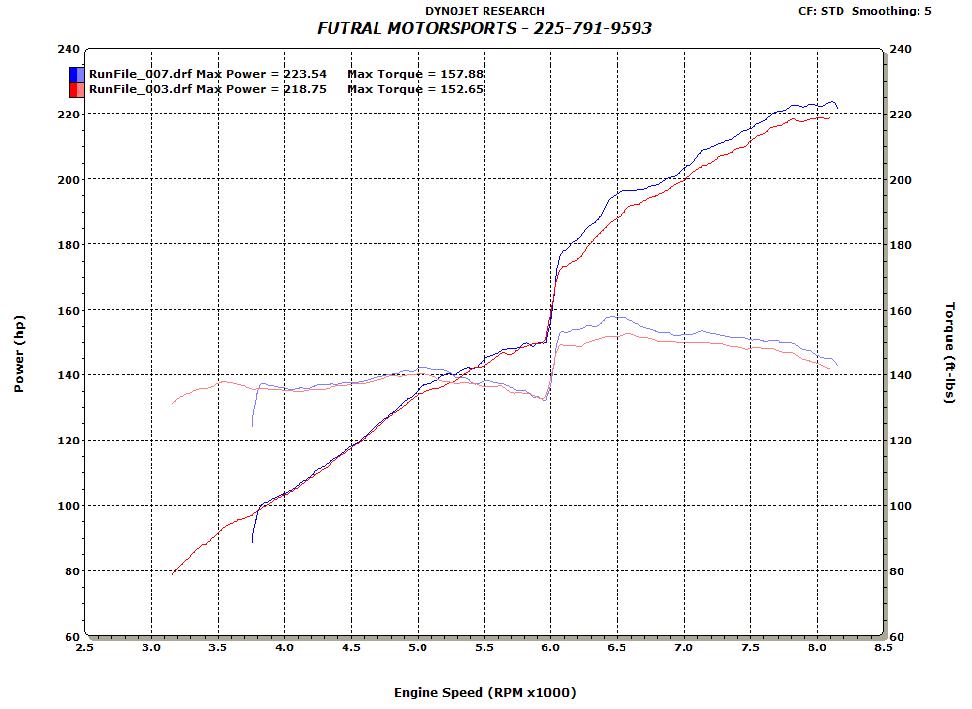Questions about AFR @ WOT
#1

Thread Starter
A lot of the post I read on here basically state that it's almost a rule of thumb that your car will run more lean with full bolt ons and the stock tune.
I had my car dyno'd with the following mods and this is what the AFR was.
First dyno picture:
AEM V2 CAI
Ballade Sports 70mm TB
63.5mm BerkTest Pipe
J's Racing 70RS catback
It seemed to run more lean compared to when I dyno'd in the second picture with:
AEM V2 CAI
Ballade Sports 70mm TB
Private Label Header
70mm BerkTest Pipe
J's Racing 70RS catback

Anyone have any idea why it would be seemingly running a better mixture than what it's commonly thought to happen?
Before at WOT it would spike to over 14.5 at higher rpm vs now it doesn't really go over 14.0 at higher rpm. But at lower rpm it does now. I'm just looking for some insight.
I had my car dyno'd with the following mods and this is what the AFR was.
First dyno picture:
AEM V2 CAI
Ballade Sports 70mm TB
63.5mm BerkTest Pipe
J's Racing 70RS catback
It seemed to run more lean compared to when I dyno'd in the second picture with:
AEM V2 CAI
Ballade Sports 70mm TB
Private Label Header
70mm BerkTest Pipe
J's Racing 70RS catback

Anyone have any idea why it would be seemingly running a better mixture than what it's commonly thought to happen?
Before at WOT it would spike to over 14.5 at higher rpm vs now it doesn't really go over 14.0 at higher rpm. But at lower rpm it does now. I'm just looking for some insight.
#2
You have a static/set fuel tune from factory. A change in afr is caused by a change in ambient temps and the bolt ons chosen such as a header in your case, which have a efficiency/breathing rpm range which will show a leaner afr where they are most efficient, and a decrease where they are not. Generally, bolting on a exhaust part and seeing a decrease in afr means its not an affective part towards the goal of making more power. Almost always some portion of the rpm band will suffer to have a benefit somewhere else in the rpms when it comes to headers. Rarely do you see an increase across the entire rpm range, when the baseline is as good as our factory header. Deciding where in the rpms your willing to give up power to gain somewhere else is up to the user. Many aftermarket headers perform worse then stock across the entire rpm range, which I'm inclined to say is your case by your afr map before and after, if I am understanding it correctly.
#5

Thread Starter
You have a static/set fuel tune from factory. A change in afr is caused by a change in ambient temps and the bolt ons chosen such as a header in your case, which have a efficiency/breathing rpm range which will show a leaner afr where they are most efficient, and a decrease where they are not. Generally, bolting on a exhaust part and seeing a decrease in afr means its not an affective part towards the goal of making more power. Almost always some portion of the rpm band will suffer to have a benefit somewhere else in the rpms when it comes to headers. Rarely do you see an increase across the entire rpm range, when the baseline is as good as our factory header. Deciding where in the rpms your willing to give up power to gain somewhere else is up to the user. Many aftermarket headers perform worse then stock across the entire rpm range, which I'm inclined to say is your case by your afr map before and after, if I am understanding it correctly.
From before the header and larger test pipe and after.

#6
One thing to note is that VTEC motors can be "over-scavenged", which means that the cylinders can be scavenged so hard that fresh intake charge gets pulled straight through the cylinder during valve overlap (intake and exhaust valves both open at the same time). When that happens, the exhaust gas will be mixed with a bit of fresh charge, which results in the sensor reporting a leaner than actual AFR. Basically, the true AFR in the cylinder isn't necessarily the same as what comes out the exhaust. That's a big reason why the S2000 gets such bad gas mileage, and builds up so much soot on the rear bumper...
Trending Topics
#10

readings at a tail pipe sniffer location will be leaner than actual readings closer to the cylinders, your engine is likely running a bit richer than what your numbers indicate.




